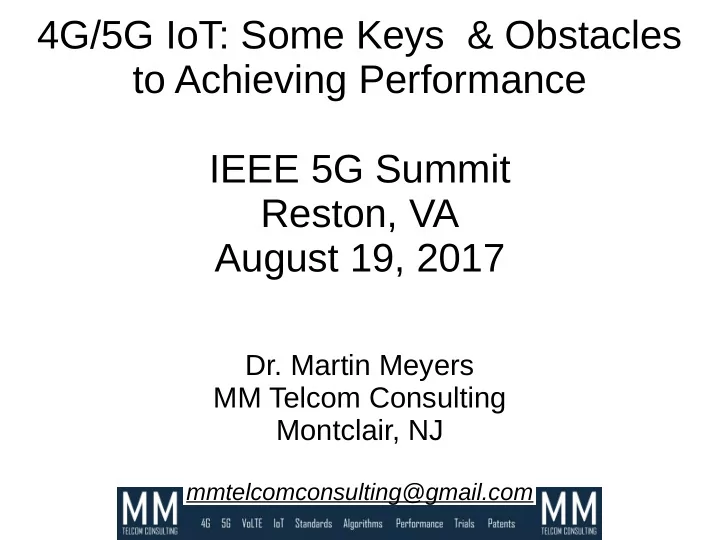

4G/5G IoT: Some Keys & Obstacles to Achieving Performance IEEE 5G Summit Reston, VA August 19, 2017 Dr. Martin Meyers MM Telcom Consulting Montclair, NJ mmtelcomconsulting@gmail.com
Interesting question #1: Where is the factor of 10x promised by Massive MIMO? Is there something fundamental missing (that academics can work on) or is it “only” an optimization (that can be done by industry)? [question from professor at IEEE 5G Workshop in Brooklyn]
Interesting question #2: I’ve read the standards and don’t see where the physical layer and the higher layers are jointly evaluated or optimized. Is this considered in the standards process? [question from graduate student at ICC2017 in Paris]
New T echnologies (cat-M, cat-1, cat-NB1) Initial System State “Expected” Performance
Where should we look for solutions and what can we learn from previous generations of wireless communications? The remainder of this presentation will propose some answers and areas to be pursued
Big Data/Analytics is the key to SON ● SON will be critical as the number of variable parameters is immense ● Big Data/Analytics has huge potential but the jury is still out ● SON must optimize over a very large set of KPIs and an even larger set of input parameters ● IoT will create a new set of critical KPIs which may vary by end user application ● It is quite easy to improve a single KPI but it is very hard to do this without harming some other KPI For example, you can easily increase DL throughput but can you do it without – impacting the UL or access?
Antennas and MIMO ● 3D adaptive antenna patterns will be critical to providing a quality signal to the user without causing excessive interference to other cells ● Past experiences, going all the way back to 2G wireless beamforming, have been quite underwhelming ● One problem seen repeatedly has been that the gains predicted by the PHY are limited by other factors Confjguration changes needed – Channel estimation and quality of feedback – Global vs. local convergence – Minimum performance specifjcations & implementation error – ● IoT, with small transmissions, will put new constraints on algorithms due to operation without the convergence that can be available with longer and larger transmissions
Identifying Limiting Factors is Critical ● There are numerous channels, both physical and logical, that can impact performance predicted by layer 1 (e.g. grant availability, channel estimation) ● The UL and DL impact each other in both obvious and subtle ways IP traffjc and RLC are bi-directional – ● Power control and adaptation of many loops are bi- directional ● Most PHY studies and simulation are uni-directional and/or oversimplifjed and will give optimistic performance estimates. They should be viewed as upper bounds on achievable performance ● Mean values can mislead us (and often does!)
T ails of Distributions vs. Mean Case: Large # of small data users Using a fixed mean level of IoT is unrealistic and heavily optimistic IOT (dB) 35 30 25 20 IOT (dB) 15 10 5 0 200 400 600 800 1000 1200 1400 1600 1800 2000
T ails of Distributions vs. Mean Mean value can completely miss key tail limitations A hypothetical illustrative example 6 UL grants assumed available per TTI 4 grants peak average use looks good BUT ==> blocking > 30-40% can still occur UL grants per TTI 4 % no UL grants 3.5 3 45 40 2.5 35 UL grants per 30 2 TTI 25 1.5 20 15 1 10 0.5 5 0 0 200 400 600 800 1000 1200 1400 1600 1800 2000 200 600 1000 1400 1800
Latency ● Internal latencies impact performance everywhere ● Expiration timers, number of re-tries, HARQ ● VoLTE and latency sensitive traffjc (QoS) ● How robust to IoT traffjc will co-existing traffjc be? ● How robust to co-existing traffjc will IoT be? ● Latency impact on loops that need to converge yet have very short burst transmission times?
Mobility: Cell Selection/Pilot Pollution ● Cell edge throughput is typically overestimated due to mobility and HO hysteresis ● 50% of the time in the HO zone, the UE will be on the weaker cell
Mobility: Cell Selection/Pilot Pollution ● How will IoT devices work in multi-pilot areas? Suffjcient signal power, low SNR and varying non-stationary strongest pilot – Need fast idle mode selection of pilot without excessive processing –
IoT—Dedicated or Shared Spectrum ● If sharing spectrum with 4G, will large number of IoT users impact VoLTE? ● What will be the impact on UL & DL control channel grants? ● Can access channels support the load generated by huge numbers of IoT devices ● IoT users will create burstier (higher variance) interference
Interesting question #1: Where is the factor of 10x promised by Massive MIMO? Is there something fundamental missing (that academics can work on) or is it “only” an optimization (that can be done by industry)? [question from professor at IEEE 5G Workshop in Brooklyn] The PHY layer alone is insuffjcient to predict and ensure end- end system level performance. Therefore, it is fundamental to understand the end-end system and jointly optimize the PHY with other layers. The hard part is knowing which components are a suffjcient set to include.
Interesting question #2: I’ve read the standards and don’t see where the physical layer and the higher layers are jointly evaluated or optimized. Is this considered in the standards process? [question from graduate student at ICC2017 in Paris] The standards bodies do a fantastic job under very tight time constraints. Integrating the PHY with upper layers, control channels and more would seriously impact delivery schedules. There is also a component of parameter optimization that could be implementation dependent. As I told the graduate student, understanding end-end performance across multiple layers is a prescription for lifetime job security.
Thank you! Dr. Martin Meyers MM Telcom Consulting Montclair, NJ mmtelcomconsulting@gmail.com
Recommend
More recommend